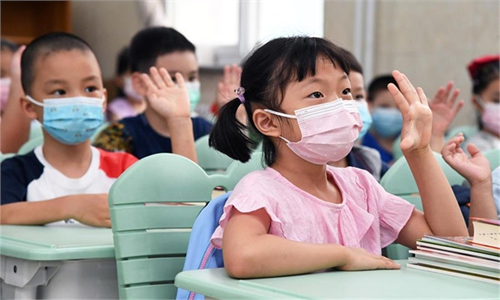
A doctor performs auscultation screening on a child in Yuepuhu county on May 13, 2023.Photo:Li Hao/GT
There's nothing to worry about China's drop in population as the decisive factors for the country's long-term economic growth lie in how to boost and take advantage of sufficient manpower rather than the total size of the population, leading Chinese demographers said one day ahead of Chinese Population Day, which falls on June 11.
Anxiety in society has emerged since data showed that the country's population in 2022 fell for the first time since 1962, and there are strong voices downplaying China's future economic growth prospects. One popular opinion in the academic community is that the country's demographic dividend will end, which comes with a significant decrease in economic growth prospects.
These misunderstandings confuse population size and human resources, Li Daokui, director of Tsinghua University's Academic Center for Chinese Economic Practice and Thinking (ACCEPT), said during a seminar held by the China Population Association over the weekend.
Li explained the core factors that impact economic development of one country or one region are not the total amount of people or of young people but the amount of population who are active, healthy, skilled and eager to engage in economic activities.
By the end of 2022, the Chinese mainland population was 1.41175 billion, a decrease of 850,000 over that at the end of 2021, data released by the National Bureau of Statistics showed.
With the continuous improvement of China's average life expectancy and average education level, taking the total working-age population in the traditional sense as the measurement of effective labor supply can no longer accurately reflect the current situation of human resources in society, Li told the seminar.
Manpower resources refer to the labor force that is capable of engaging in production and driving economic development. Human resources can be considered as the sum of social labor time reserves taking into account the quality of the population, and the total human resources is the equivalent of the healthy and educated population, according to Li.
The focus of China's harvest of its demographic dividend has been transformed from the population number and population structural advantages since the reform and opening-up, to the second centennial goal of the new era with more emphasis on the improvement of population quality based on capital population opportunities and human capital dividends, according to Yuan Xin, deputy head of the China Population Association and a demographer from Nankai University in Tianjin.
Since the reform and opening-up, China's population quality has seen earth-shaking changes and the accumulation of human capital is increasingly abundant, which will be the main power source of high-quality economic development in the future, Yuan told the Global Times on Sunday, dismissing voices claiming the country's demographic dividend has disappeared.
China has built the world's largest higher education system, Yuan said, and he listed several figures for the Global Times. He said that the total accumulative number of people who have received higher education has reached 240 million, accounting for 17 percent of the total population, that is, roughly one in six people in the country has a college degree, Yuan said.
Data from China's annual college entrance examinations, or gaokao, which concluded on Saturday this year nationwide, also indicated that more and more Chinese youth are receiving higher education, and this will provide more high-quality human resources for economic and social development, Yuan noted.
A record 12.91 million candidates applied for this year's gaokao, marking an increase of 980,000 from 2022. Since 2018, the number of applicants for gaokao has increased each year, according to figures released by the Ministry of Education.
At the Sunday seminar, Chinese demographers also highlighted the urgency of addressing possible long-term problems caused by population declines so as to prompt the high-quality development of the population. They recommended taking more measures to release the nation's fertility potential and stimulate people's fertility motivation.
Explaining why the Chinese young generation has lower fertility willingness, Yuan - who also attended the seminar - said lives of most young people are centered on self-development and self-pleasure, rather than on having children. Young people pursue their own development and happiness, and if having children will hinder their development and enjoyment of life, they will choose not to have children or even not to marry.
The related discussions about how Yuan interprets fertility have become a heated topic on Chinese social media on the Chinese Population Day. Some netizens were displeased by the term "self-centered" and argued that the main cause for reluctance to give birth is the high pressure of raising a child.
As a method to boost the fertility rate, various localities have introduced support measures from the beginning of this year, such as issuing maternity allowances and childcare subsidies, and strengthening housing security support.




